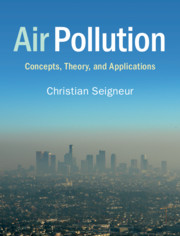Book contents
- Air Pollution
- Air Pollution
- Copyright page
- Contents
- Preface
- Main Notations
- 1 Brief History of Air Pollution
- 2 Emissions of Air Pollutants and Emission Control Technologies
- 3 Meteorology: General Circulation
- 4 Air Pollution Meteorology
- 5 Atmospheric Radiative Transfer and Visibility
- 6 Atmospheric Dispersion
- 7 The Stratospheric Ozone Layer
- 8 Gaseous Pollutants
- 9 Atmospheric Particles
- 10 Clouds and Acid Rain
- 11 Transfer of Pollutants between the Atmosphere and Surfaces
- 12 Health Effects
- 13 Environmental Impacts
- 14 Climate Change and Air Pollution
- 15 Regulations and Public Policies
- Index
- References
7 - The Stratospheric Ozone Layer
Published online by Cambridge University Press: 19 June 2019
- Air Pollution
- Air Pollution
- Copyright page
- Contents
- Preface
- Main Notations
- 1 Brief History of Air Pollution
- 2 Emissions of Air Pollutants and Emission Control Technologies
- 3 Meteorology: General Circulation
- 4 Air Pollution Meteorology
- 5 Atmospheric Radiative Transfer and Visibility
- 6 Atmospheric Dispersion
- 7 The Stratospheric Ozone Layer
- 8 Gaseous Pollutants
- 9 Atmospheric Particles
- 10 Clouds and Acid Rain
- 11 Transfer of Pollutants between the Atmosphere and Surfaces
- 12 Health Effects
- 13 Environmental Impacts
- 14 Climate Change and Air Pollution
- 15 Regulations and Public Policies
- Index
- References
Summary
The stratospheric ozone layer results from the photolysis of molecular oxygen by ultraviolet (UV) solar radiation in the high atmosphere. This large atmospheric layer is stable and, therefore, affects the general atmospheric circulation by decreasing significantly the vertical motions of air parcels. In addition, ozone protects the Earth from harmful UV radiation. Therefore, its destruction by anthropogenic activities may lead to public health impacts. This chapter presents first some fundamentals of atmospheric chemical kinetics (i.e., the speed at which chemical reactions occur in the atmosphere), which are needed to understand the processes leading to the presence of the ozone layer. These notions are also needed to understand the formation of gaseous and particulate pollutants, which is presented in the following chapters. Next, the processes that govern the ozone layer are described in terms of its natural formation and its destruction by man-made substances. Finally, the public policies introduced to address the protection of the stratospheric ozone layer are summarized.
- Type
- Chapter
- Information
- Air PollutionConcepts, Theory, and Applications, pp. 125 - 145Publisher: Cambridge University PressPrint publication year: 2019



